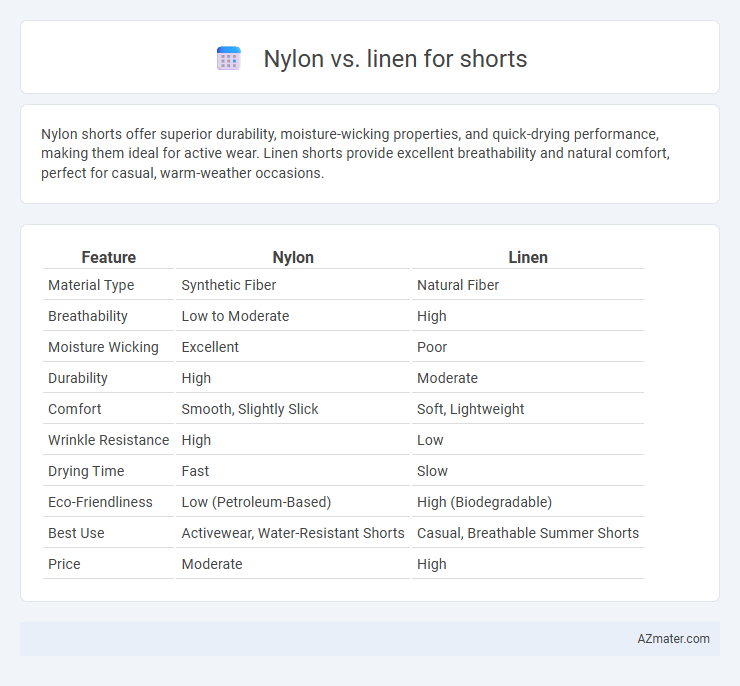Nylon shorts offer superior durability, moisture-wicking properties, and quick-drying performance, making them ideal for active wear. Linen shorts provide excellent breathability and natural comfort, perfect for casual, warm-weather occasions.
Table of Comparison
| Feature | Nylon | Linen |
|---|---|---|
| Material Type | Synthetic Fiber | Natural Fiber |
| Breathability | Low to Moderate | High |
| Moisture Wicking | Excellent | Poor |
| Durability | High | Moderate |
| Comfort | Smooth, Slightly Slick | Soft, Lightweight |
| Wrinkle Resistance | High | Low |
| Drying Time | Fast | Slow |
| Eco-Friendliness | Low (Petroleum-Based) | High (Biodegradable) |
| Best Use | Activewear, Water-Resistant Shorts | Casual, Breathable Summer Shorts |
| Price | Moderate | High |
Introduction to Nylon and Linen Shorts
Nylon shorts are prized for their lightweight durability, moisture-wicking properties, and quick-drying capabilities, making them ideal for active wear and outdoor activities. Linen shorts offer superior breathability and natural cooling, with a textured, relaxed look perfect for casual summer outfits. Both fabrics provide unique comfort and performance benefits, catering to different style and functionality preferences in warm weather.
Fabric Properties: Nylon vs Linen
Nylon fabric offers exceptional durability, moisture-wicking, and quick-drying properties, making it ideal for active or outdoor shorts. Linen boasts natural breathability, lightweight texture, and excellent moisture absorbency, promoting comfort in hot, humid conditions. While nylon resists wrinkles and maintains shape under stress, linen provides superior softness and a casual, breathable feel but wrinkles more easily.
Comfort and Breathability Comparison
Nylon shorts offer excellent durability and moisture-wicking properties but tend to retain heat and may cause discomfort during prolonged wear in hot, humid conditions. Linen shorts provide superior breathability and natural ventilation, making them ideal for keeping cool and comfortable in warm climates. The lightweight, absorbent nature of linen enhances comfort by allowing air circulation, while nylon's synthetic fibers prioritize quick drying but may sacrifice some breathability.
Durability and Longevity
Nylon shorts offer superior durability and resistance to abrasions compared to linen, making them ideal for active wear and prolonged use. Linen, while breathable and comfortable, tends to wear out faster due to its natural fiber composition and lower tensile strength. For longevity, nylon maintains its shape and color better over time, ensuring shorts remain in good condition through multiple washes and outdoor activities.
Moisture-Wicking and Quick-Dry Features
Nylon shorts excel in moisture-wicking due to their synthetic fibers designed to pull sweat away from the skin, promoting faster evaporation and enhanced quick-dry properties. Linen, made from natural flax fibers, offers moderate moisture absorption but tends to retain moisture longer, leading to slower drying times. For active wear or humid conditions, nylon provides superior performance in managing sweat and maintaining comfort during prolonged use.
Style and Aesthetic Differences
Nylon shorts offer a sleek, modern aesthetic with a smooth, slightly shiny finish that enhances sporty and casual looks, while linen shorts provide a natural, textured appearance that exudes effortless, breathable elegance suited for summer and beachwear. The lightweight and crisp nature of linen create a relaxed, vintage vibe, contrasting with nylon's durable, contemporary edge ideal for active lifestyles. Style choices between nylon and linen shorts reflect a balance between functional performance and timeless casual sophistication.
Maintenance and Care Requirements
Nylon shorts require minimal care, as they are quick-drying, wrinkle-resistant, and can be machine washed on a gentle cycle without losing shape. Linen shorts demand more delicate maintenance, often needing hand washing or dry cleaning to prevent shrinking and preserve fabric texture. The natural fibers in linen are prone to wrinkles and may require ironing, whereas nylon provides easier upkeep for active or travel wear.
Environmental Impact and Sustainability
Nylon production relies heavily on petrochemicals, resulting in significant carbon emissions and non-biodegradable waste, which challenges its environmental sustainability. Linen, derived from flax plants, is biodegradable and requires less water and pesticides, making it an eco-friendlier option for shorts. Choosing linen shorts supports sustainable agriculture and reduces microfiber pollution compared to nylon alternatives.
Best Uses and Activities for Each Fabric
Nylon shorts excel in high-performance activities such as running, hiking, and water sports due to their lightweight, moisture-wicking, and quick-drying properties. Linen shorts are ideal for casual wear and warm-weather activities like beach outings and leisurely strolls because of their breathability, natural texture, and superior comfort in heat. Choosing nylon ensures durability and stretch for active use, whereas linen offers a stylish, breathable option suited for relaxed, everyday wear.
Nylon vs Linen Shorts: Which Should You Choose?
Nylon shorts offer superior moisture-wicking, quick-drying properties, and high durability, making them ideal for athletic activities and outdoor adventures. Linen shorts provide excellent breathability and a natural, lightweight feel, perfect for hot weather and casual wear but tend to wrinkle easily and lack the stretch of synthetic fabrics. Choosing between nylon and linen shorts depends on whether you prioritize performance and resilience or comfort and a breathable, stylish look.

Infographic: Nylon vs Linen for Shorts
 azmater.com
azmater.com